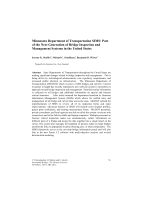Bridges

- Publication no: ABC-AMM005-11
- Published: 31 October 2011
- PDF (free) Download
State Departments of Transportation throughout the United States are making significant changes related to bridge inspection and management. This is being driven by technological advancements, new regulatory requirements, and increased public attention on infrastructure. The Minnesota Department of Transportation (MN/DOT) which oversees 21,000 bridges and culverts 3 metres or greater in length has recently implanted a new software system to streamline its approach toward bridge inspection and management. Detailed routine information is collected on all bridges and additional information on special and fracture critical structures. After initial research the department launched its Structure Information Management System (SIMS) which allows for unified entry and management of all bridge and culvert data across the state. Mn/DOT utilised the implementation of SIMS to review all of its inspection forms and make improvements. Advanced features of SIMS will include scour channel profiles, gusset plate worksheets, and bearing measurement forms. Mn/DOT personnel, private consultants, and local agencies are able to utilise the system via secure web connections and in the field on tablet and laptop computers. Multiple personnel on fracture critical inspection teams can simultaneously collect information on different parts of a bridge and merge the data together into a single report on the server. The system also manages the hundreds of pictures taken on large bridges and directly links to appropriate location (bearing, pier, or other component). The SIMS framework serves as the one-stop bridge information portal and will also link to the new Pontis 5.2 software with multi-objective analysis and revised deterioration modeling.
